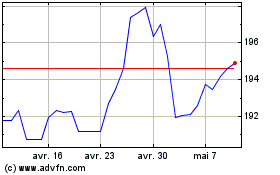UK Industrial Output Falls For Third Month; Trade Deficit Widens
11 Mai 2017 - 9:00AM
RTTF2
UK industrial production declined for the third consecutive
month in March and the trade gap widened notably on higher imports,
erasing hopes for an upward revision to the first quarter
growth.
Industrial production fell 0.5 percent month-on-month, following
a 0.8 percent drop in February, data from the Office for National
Statistics showed Thursday.
This was the third consecutive decrease in output. Production
was expected to fall 0.4 percent.
Likewise, manufacturing output slid 0.6 percent after easing 0.3
percent in the previous month. Economists had forecast a moderate
0.2 percent fall for March.
On a yearly basis, growth in industrial production slowed
more-than-expected to 1.4 percent in March from 2.5 percent in
February.
This was the weakest expansion in the current sequence of
five-month period of growth. The expected pace of growth was 1.9
percent.
Manufacturing output growth came in at 2.3 percent, while
economists forecast the rate to remain unchanged at 3 percent.
In a separate communique, the ONS said construction output grew
2.4 percent annually in March, representing the 12th consecutive
period of growth.
In the first quarter, industrial output grew only 0.1 percent
sequentially. For GDP calculation, ONS had estimated that
industrial production climbed 0.3 percent and construction growth
at 0.2 percent, in line with today's publication.
Another report from the ONS showed that the total trade deficit
rose to a 6-month high in March. The total trade deficit widened to
GBP 4.9 billion from GBP 2.65 billion in the previous month.
The visible trade deficit increased to GBP 13.44 billion from
GBP 11.44 billion in February. The expected level was GBP 11.6
billion.
In the first quarter, the total trade deficit rose by GBP 5.7
billion to GBP 10.5 billion. This reflected a 3.3 percent rise in
imports amid a 0.5 percent fall in exports.
The visible trade deficit widened to GBP 36.87 billion from GBP
31.64 billion in the prior quarter.
Today's activity data re-affirmed that the economy lost some
momentum in the first quarter but showed some signs that GDP growth
is becoming slightly better balanced, Scott Bowman, a UK economist
at Capital Economics, said.
Sterling vs Yen (FX:GBPJPY)
Graphique Historique de la Devise
De Mar 2024 à Avr 2024

Sterling vs Yen (FX:GBPJPY)
Graphique Historique de la Devise
De Avr 2023 à Avr 2024
